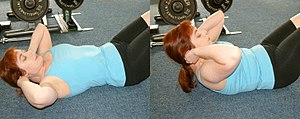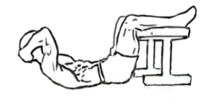Crunches
The term (classic) abdominal crunches (or crunches ) is an exercise that is used to train the abdominal muscles . It is recommended as a better alternative to sit-ups because it is much gentler and safer to do. Damage to the spine is avoided because the hips are in an optimal position during abdominal pressing due to the raised and angled position of the legs. Because the spine remains very straight, the intervertebral discs and vertebrae in the lumbar area are significantly less stressed.
General movement execution
The exercise starts with the same posture as the sit-up; so lying on your back with your legs bent to avoid a hollow back . You should have a leg-torso angle of approx. 135 °. The knee angle should be 90 ° to 100 °. If the legs are in this position, the work of the hip flexor ( psoas major muscle ) is largely blocked in order to avoid excessive development of this muscle. Keep your hands on your head. For an optimal posture in the upper body, the hands are placed on the head with the fingertips behind the ears. The arms are automatically bent. The now bent arms should be held as far out as possible, depending on the flexibility of the person. It is sufficient if the elbows are approximately at the level of the shoulders. This position of the arms and legs makes it possible to concentrate the load exclusively on the abdominal muscles. Correct execution is of course assumed. Now, with the help of the abdominal muscles, pull your upper back a little forward and up. During this movement, the head is kept in a neutral position as far as possible ( cervical spine not curved). To ensure that your lower back stays on the floor, your legs must constantly maintain their angled position without shifting. The abdominal muscles can have a supportive effect by trying to pull them in slightly when contracting. As soon as you have reached the greatest distance personally between the floor / pad and your upper back (this depends on the mobility of the person performing the exercise), the movement is carried out retrospectively. It is particularly important to ensure that when the upper back is slightly laid down, the abdominal muscles do not completely relax, but remain slightly under tension and, above all, that the lower back does not fall into a hollow back position. When performing the exercise, attention should also be paid to breathing. When lifting the upper back, you should exhale in order to achieve maximum tension in the abdominal muscles, because when inhaling, the diaphragm would press down and thus compress the internal organs in the abdomen. These would press against the abdominal muscles, which would stand in the way of optimal tension / contraction of the muscles. Therefore, inhalation should only take place in the "relaxation phase", that is, while laying down the upper back.
| Static execution | Dynamic execution |
|---|---|
| The exercise can be done statically by lifting your upper back (as in general movement) and holding this position for as long as possible until exhaustion. Here you should make sure to keep breathing lightly and not to wait to take off before inhaling. | If you hold the raised position only briefly, then lower it again and then raise it again (repeating the process of general movement execution), then you have chosen the dynamic variant of execution. |
Variations
The abdominal press is a basic type that allows many variations. A more difficult variant is z. B. the beetle .
Bibliography
- Ute Witt, Arne Weychardt: The best exercises in the world . Rowohlt-Taschenbuch-Verlag, Reinbek near Hamburg, ISBN 3-499-61582-7 .

